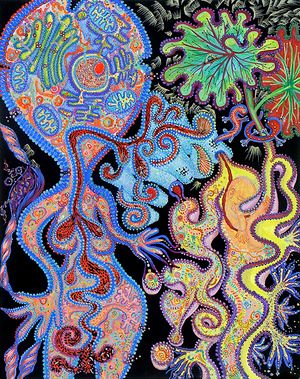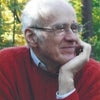
Membranes
Scientific journals almost always limit themselves to reporting the results of highly technicexperiments. Magazines for a general audience often treat scientific findings clumsily as metaphors. I have wondered whether we’d be served by a third type of publication, which would solicit conjectures that the author is not equipped to test, or otherwise fails to test, but that might inspire some one else.
For example, what if this publication contained conjectures like Fermat’s famous marginalia (his last theorem), scribbled in a book in 1637 but only proven in 1994? Of course, most conjectures have not been as fruitful as Fermat’s, not to say correct. We tend to forget that the process of discovery, taken as a whole, is often messy. Unlike Fermat’s, most conjectures are wrong, so the challenge is not only proving the few, but generating the many and then considering them.
I am told that at Google, it’s a firing offense to shoot down any idea before it’s had an opportunity to be explored, even played with, and perhaps to inspire still other ideas.
When at Columbia University the physicist Wolfgang Pauli presented his non-linear field theory of elementary particles, worked out with Werner Heisenberg, Niels Bohr was in the audience. Asked for his group’s opinion, Bohr replied, as reported by Freeman Dyson, “We are all agreed that your theory is crazy. The question that divides us is whether it is crazy enough to have a chance of being correct.”
Of course far from all ideas that seem crazy turn out to be correct, but ideas that challenge a prevailing paradigm often seem crazy. What if there were a publication that contained not reports of careful experiments, after peer review, as scientific journals do, but unproven conjectures? As at Google, now one of the most valuable corporations in the world, perhaps even an idea that turns out to be wrong would be useful in suggesting a further idea.
Thanks to the recorder on my cell phone, I can offer on example. Sitting alone in a diner booth, I overheard the following conversation
A: What if our brains are always generating the imagery associated with classic psychedelics? What if ordinary reality is produced by relegating this wild imagery to the unconscious?
B: That feels ridiculous, even (unintelligible). Everyone knows that psychedelics work by amplifying what we call ordinarilyconsciousness, or distorting or playing with it, by activating new circuits in the brain.
A. Well, just play along for a while. It’s widely recognized that an optimal psychedelic session does not involve the operation of heavy machinery, or exposure to other dangers.…
B: or irrevocable life decisions. I know, but how does that prove your point?
A: Well, imagine that in evolutionary history, this wild imagery developed, as we know that the ability to dream developed, and the ability to speculate (to imagine things that aren’t but might be). In the case of wild imagery, this ability might impose an evolutionary disadvantage, and would be either selected against or somehow suppressed.
B: But you speculate that we all still have this psychedelic flow?.
A: Yes, and that we developed the ability automatically to keep it out of consciousness, just as we learn that dreams aren’t “real” and we learn to keep secret fantasies that are socially and maybe personally unacceptable.
B: So, in the case of this constant stream of psychedelic imagery, we somehow block it from consciousness?
A: Yes, in order to deal with immediate demands of life.
B: And psychedelics do what?
A: In this conjecture, they deactivate the part of the brain that ordinarily keeps this imagery out of consciousness.
B: They temporarily block the mental blocker favored by evolution?
A: Yes. We know the brain is highly selective with regard to socially unacceptable fantasies, and to what Jung called the “shadow,” or impulses that are contrary to our identity and that we may project onto others.
B: Well, the vision of a constant flow of psychedelic imagery would cast the “war on drugs” in a new light.
A: As the ideas of Freud and Jung and other psychologists in the last century taught us the brain is up to more tricks than people normally acknowledged.
B: Okay, let’s explore some implications.
A: I appreciate your taking this seriously, at least for a while, or at least pretending to do so.
B: Okay, what you are saying is that psilocybin or another classic psychedelic doesn't create the wild imagery; it reveals the imagery?
A: Yes, and this includes a conjecture about evolutionary history. Somehow the wildness began to get started in the connections of all those neurons, but it was disadvantageous for ordinary life. An emergent part of the brain that kept the flow out of consciousness was selected for. Here we are.
B: But I gather that magnetic resonance imaging has shown a brain activation after the ingestion of psychedelics.
A: That is not inconsistent with the conjecture. When the restraint is deactivated by the drug, then new connections could occur.
B: So this conjecture posits a brain structure that ordinarily keeps an ongoing psychedelic flow out of consciousness?
A: Yes, and as you suggest, an inherent psychedelic flow in every human, a flow that he or she is ordinarily unaware of.
B: That is a mischievous idea, almost a scandalous idea.
A: So if this conjecture were correct, psychedelics feel dangerous not because they induce fantasies, but because they uncover something that is naturally occurring.
At this point the waitress came by with my change, and noticing the time, I had to leave. But if I ever hear of a website devoted to conjectures, I will try to find these guys. They looked normal, at least for graduate students. Chances are, they are mistaken, but who knows?
